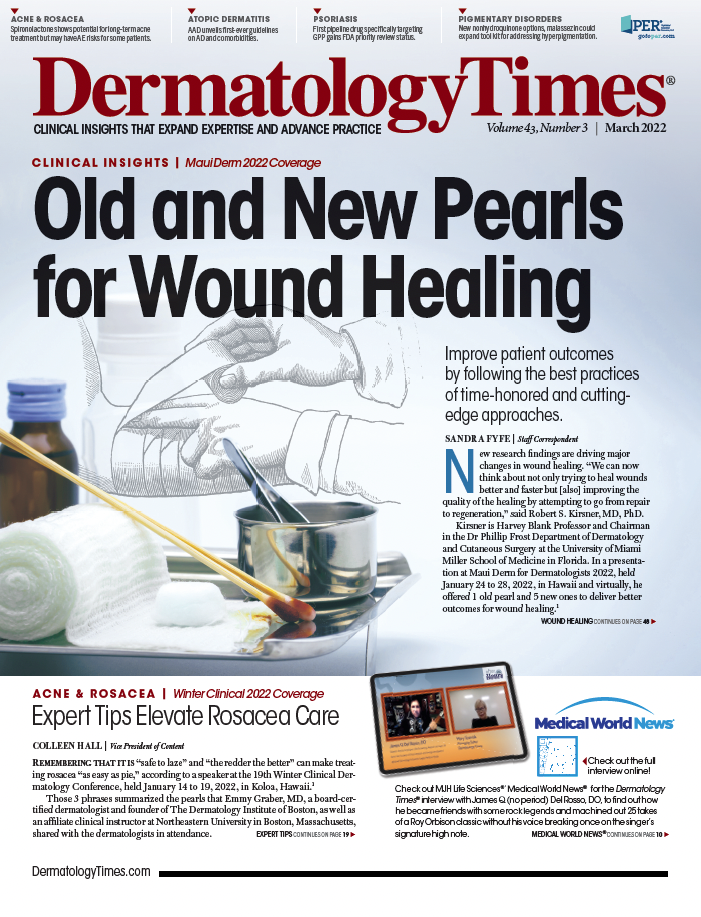- Acne
- Actinic Keratosis
- Aesthetics
- Alopecia
- Atopic Dermatitis
- Buy-and-Bill
- COVID-19
- Case-Based Roundtable
- Chronic Hand Eczema
- Drug Watch
- Eczema
- General Dermatology
- Hidradenitis Suppurativa
- Melasma
- NP and PA
- Pediatric Dermatology
- Pigmentary Disorders
- Practice Management
- Precision Medicine and Biologics
- Prurigo Nodularis
- Psoriasis
- Psoriatic Arthritis
- Rare Disease
- Rosacea
- Skin Cancer
- Vitiligo
- Wound Care
Publication
Article
Dermatology Times
Update on the Genetics of Vitiligo
Author(s):
Vitiligo can have a profound effect on mental health and quality of life.
Vitiligo is a chronic, acquired autoimmune disease that results in depigmented macules and patches. Prevalence varies around the world, where it is more common in Africa and Europe than in North America. There is no discrepancy between different sexes and although it can affect children, the mean age of disease onset is around 20-30 years of age. Although vitiligo does not lead to scarring or other long term physical sequalae, it can have a profound effect on mental health and quality of life. While there is no cure for vitiligo, there are several off-label medications, and one FDA-approved medication, which are somewhat effective in treating the disease. Most of these medications are immunosuppressive in nature, given that the autoimmune attack against melanocytes in this disorder. While failure of immune tolerance is thought to be the main etiology of vitiligo, its pathogenies are considered multifactorial including dysregulation of adaptive immunity, innate immunity, and certain genetic factors. A recent 2022 review article sought to provide an update on the latest research concerning the genetic susceptibility of vitiligo.1
The attributable risk of vitiligo due to genetic factors is estimated to be as high as 83%, but it still remains a multifactorial disease with a polygenic inheritance pattern. Linkage analysis and positional cloning has demonstrated that chromosome 22q12 has been associated with vitiligo pathogenesis, specifically through regulation of the XBP1 transcription factor. Three loci, at 1p31.3-p32.2, 7q21.11 and 8p12 have been found to be linked with vitiligo susceptibility in Europeans. One loci, 4q13-q21 has been linked to vitiligo susceptibly in the Asian populations. HLA class I and II-related gene have also been implicated. Amino acid alterations at residues 135 and 45-65 for HLA-DBQ1 and HLA-B respectively has been found to be a strong risk factor in the Chinese population.2 Other HLA types have been found to be associated with the risk of vitiligo in populations including China, India, Slovakia, Italy, and Germany.
Furthermore, five GWAS studies have been performed for vitiligo in European and Asian populations and most of the loci identified by GWAS were detected in Europeans, suggesting a possible specific ethnicity effect. Overall, these GWAS analyses have identified more than 50 loci associated with the risk of vitiligo. Candidate genes for vitiligo include the DDR1 gene, which encodes a protein that helps anchor melanocytes to the basement membrane. This protein has been found to be decrease in vitiligo patients as compared to controls.3 Another candidate gene is the CHD1 gene which also plays a role melanocyte adhesion. Marchioro et. al. highlight all the main genes and histocompatibility antigens (HLA) involved in the pathogenesis of vitiligo in their recent review paper.1
Interestingly, research on the genetics of vitiligo has demonstrated that certain HLA types are correlated with specific subtypes of vitiligo in the Brazilian population. Common, acrofacial, and mixed vitiligo has been shown to be associated with HLA-DBQ*06 while HLA-A*32 has been linked with the localized form (focal and segmental). Given that there have been conflicting reports in the literature with these genetic associations, the HLA-DQB1*06 and HLA-A*32 patterns may only be valid in the Brazilian populations4. While more research is needed on the exact pathophysiology of vitiligo, it is becoming more clear that is a multifactorial condition that can be influenced by genetics.
References
- Marchioro HZ, Silva de Castro CC, Fava VM, Sakiyama PH, Dellatorre G, Miot HA. Update on the pathogenesis of vitiligo. An Bras Dermatol. 2022;97(4):478-490. doi:10.1016/j.abd.2021.09.008
- Yang C, Wu J, Zhang X, et al. Fine-mapping analysis of the MHC region for vitiligo based on a new Han-MHC reference panel. Gene. 2018;648:76-81. doi:10.1016/j.gene.2018.01.053
- Reichert-Faria A, Jung JE, Moreschi Neto V, de Castro CCS, Mira MT, Noronha L. Reduced immunohistochemical expression of Discoidin Domain Receptor 1 (DDR1) in vitiligo skin. J Eur Acad Dermatol Venereol JEADV. 2013;27(8):1057-1059. doi:10.1111/jdv.12013
- Ramire LD, Marcos EVC, Godoy DAS, de Souza-Santana FC. Association of class I and II HLA alleles and haplotypes with susceptibility to vitiligo: a study of patients with vitiligo from southeast Brazil. Int J Dermatol. 2016;55(6):e347-355. doi:10.1111/ijd.13194

Newsletter
Like what you’re reading? Subscribe to Dermatology Times for weekly updates on therapies, innovations, and real-world practice tips.


























